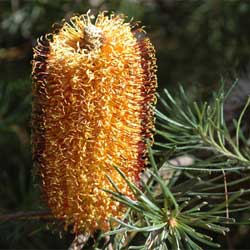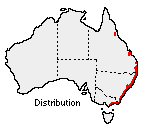Banksia spinulosa
 |
 |
Hairpin Banksia
Banksia spinulosa, sometimes known as Hairpin Banksia, is native to the three eastern States of Australia, extending along the coast from Victoria to Cairns and distributed from the coastline into forest areas of the Great Dividing Range, In coastal areas of New South Wales it tends towards a dwarfed habit but further in the mountains it is taller and more upright.

B. spinulosa varies greatly in height (1 -3 m) and flower *colour, with variations of brown, red, orange and gold. The flower spikes range from 10-20 cm in length. The individual flowers open from the top of the spike and provide a long flowering period from autumn through the winter to spring when the three stages of cone development can be observed - bud, flower spike and seed capsule. Leaves are long and narrow, 3-8 cm long by 2-7 mm wide, and variably toothed.
Open growing produces a compact symmetrical shrub but dense shade or heavy plant competition can result in open spindly growth.
Pruning is mostly unnecessary if the plant is not in a confined position. It should form a rounded shrub about 2 m diameter in open sun.
B. spinulosa grows well in soils ranging from light through to moderately heavy with good moisture and drainage. Soils with high lime content lead to yellowing foliage and poor growth. Canberra winter frosts do not impede its growth and forms from southern sources can be regarded as frost hardy.
lt is easily propagated from seed which can be sown all year round under glass. Germination occurs two to five weeks after sowing. The seed remains viable for several years. Propagation from cuttings taken in late spring is used to retain specific colour forms. Specimens grown from seed take two to three years before flowering and from five to six years to attain their full height.
Banksia spinulosa is an easy plant for the home gardener to cultivate. It has an attractive habit and many showy flower spikes. it is also a good food source for bees and nectar feeding birds and provides fine cut flowers. Few pests have been observed.
There are several recognised botanical varieties of Banksia spinulosa.
*RHS Colour Chart, 1966: perianth, orange group 26A; style, yellow group 13A
Name meaning: Banksia spinulosaBanksia commemorates Sir Joseph Banks, the botanist who travelled with Captain Cook; spinulosa with small spines, probably refers to the leaf tip, of the plant originally described |
![An Australian Government Initiative [logo]](/images/austgovt_brown_90px.gif)

